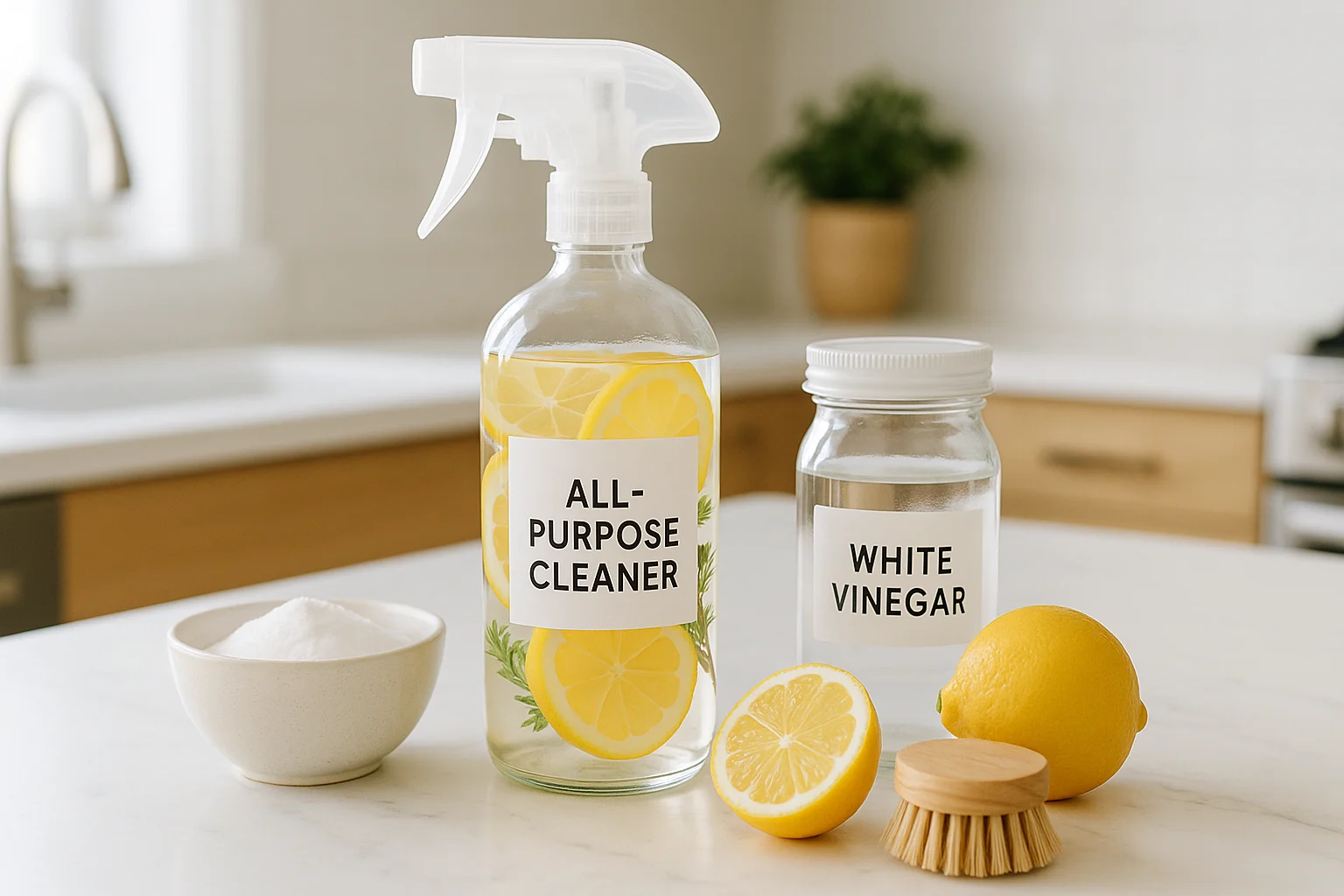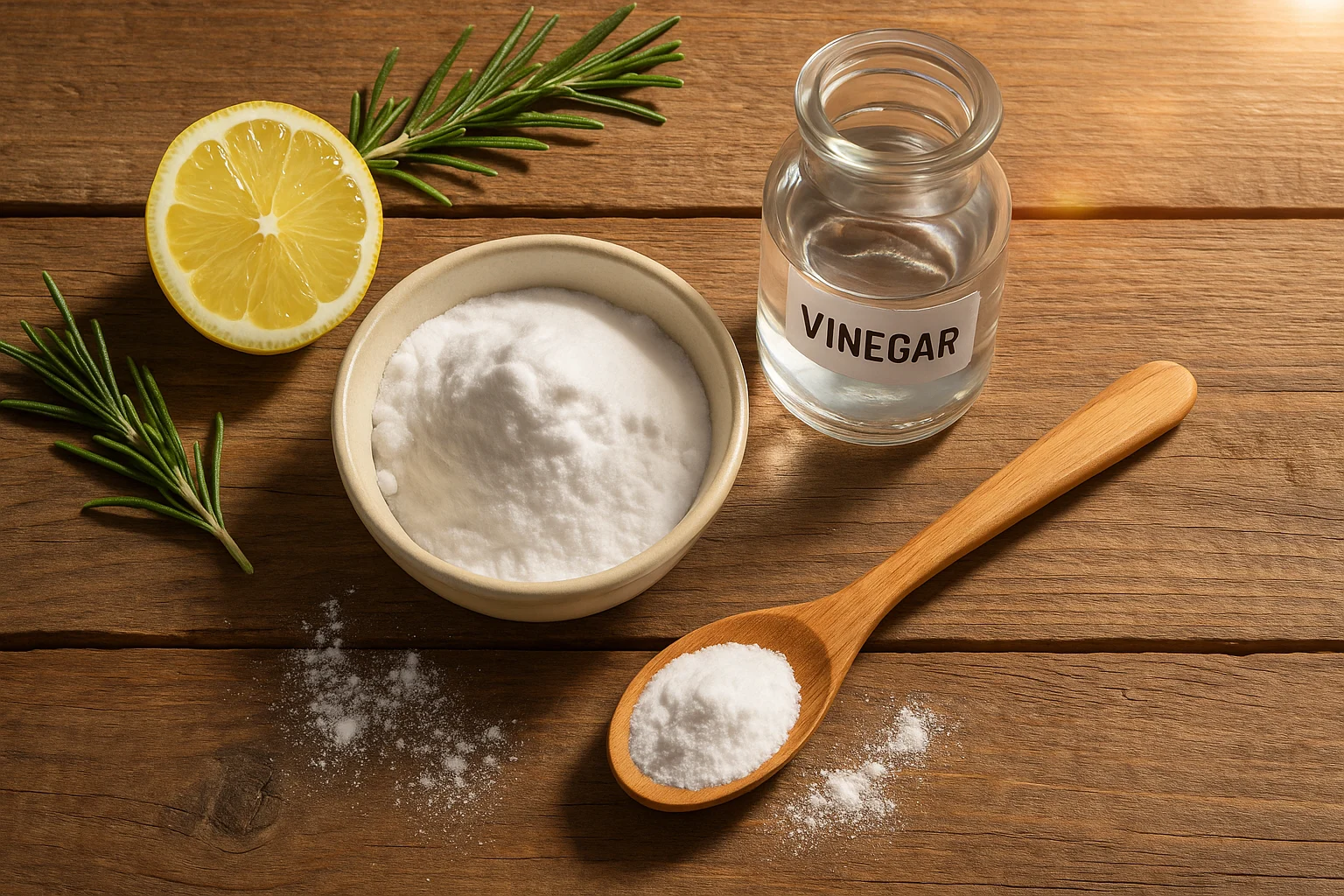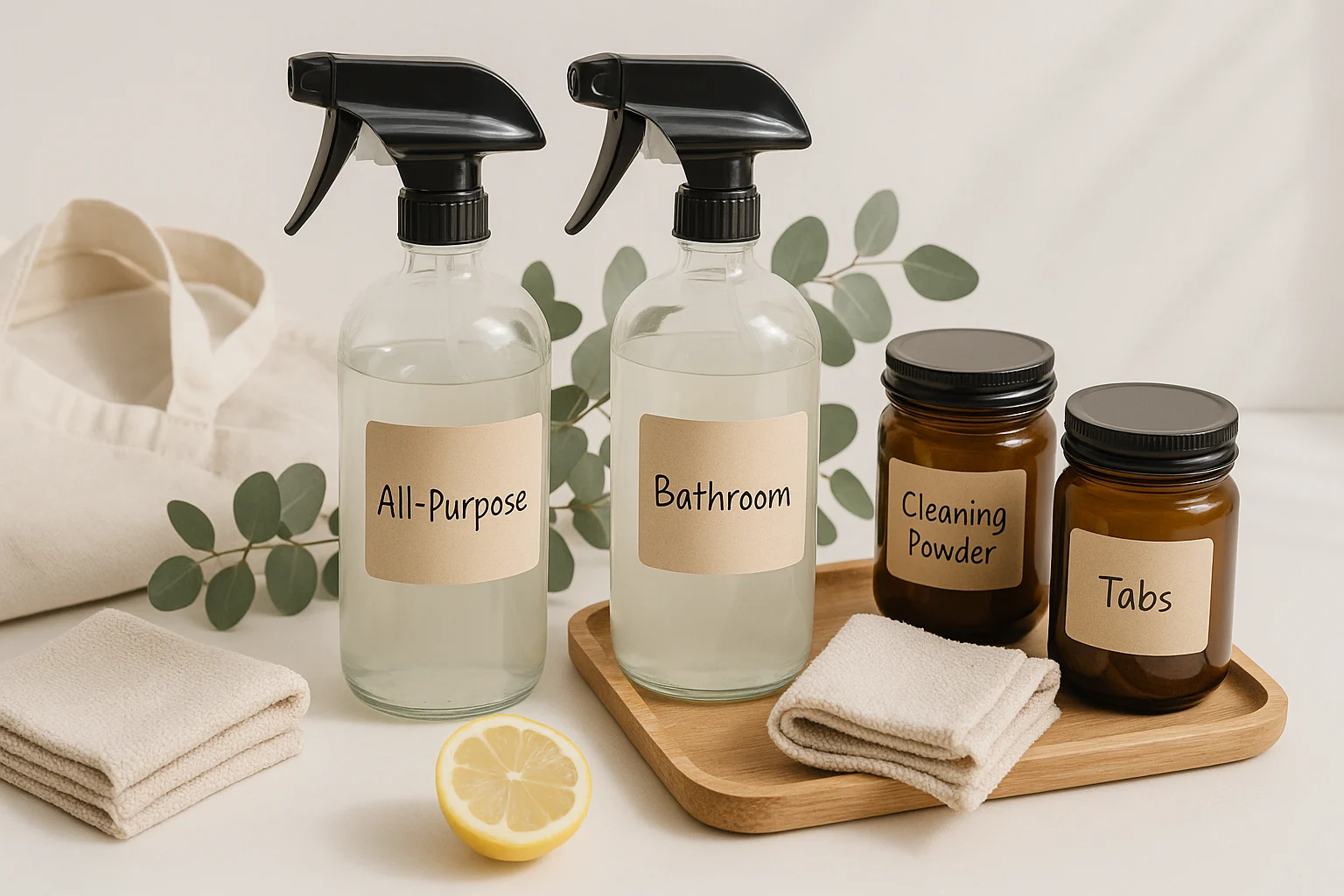
Are you sick of that harsh chemical smell lingering after cleaning? Worried about what those store-bought sprays might do to your family’s health or the environment? I used to feel the same way—until I discovered how powerful and safe DIY natural cleaners can be. In this post, I’ll walk you through the best homemade cleaning solutions using stuff you already have.
Try the Cleaner Match Tool Now!Table of Contents
- Why Choose DIY Cleaners?
- Your Essential DIY Cleaning Toolkit
- Safety Tips for Natural Cleaning Recipes
- Cleaner Match Tool: Find Your Perfect Eco-Friendly Fix
- Easy DIY Cleaning Recipes (Including Floors)
- Tips for Success with DIY Cleaners
- Troubleshooting Natural Cleaning Solutions
- Frequently Asked Questions
- Conclusion: A Cleaner, Healthier Home
Why Choose Homemade Cleaning Solutions?
Switching to DIY cleaners isn’t just a fad—it’s a game-changer for your health, budget, and the planet. Here’s why so many folks are jumping on board.
Health Benefits of Non-Toxic Cleaners
Store-bought cleaners often pack chemicals like ammonia or bleach that can spark allergies or breathing issues. Studies show indoor levels of many VOCs are often 2–5× higher than outdoors (EPA), and they can spike much higher during and right after certain activities. With natural cleaning recipes, I control what goes in, keeping my home feeling fresh. If you or your loved ones have asthma, check out these five non-toxic cleaning solutions for asthmatics to breathe easier while cleaning.
- Fewer Toxins: Skip common irritants to help reduce allergy flare-ups or skin rashes.
- Better Air: Natural cleaners can cut down on airborne chemicals—great for kids and pets.
- Kind to Skin: No more itchy hands from harsh detergents!
Save Money with DIY Cleaning Solutions
Specialized store-bought cleaners for every surface can drain your wallet! Meanwhile, eco-friendly solutions rely on cheap pantry staples. A gallon of vinegar costs about $3 and makes tons of cleaners, saving me up to 80% compared to commercial brands. To stretch your budget further, explore how to buy natural cleaning products in bulk and save over 50%.
- Budget-Friendly: Vinegar, baking soda, and lemons won’t break the bank.
- Less Waste: Reuse spray bottles to cut down on plastic trash.
Eco-Friendly Cleaning for a Healthier Planet
Vinegar-based mixes shrink environmental impact big time. Plus, they rival most eco-friendly cleaning products on the market—without the price tag.
- Less Runoff: Natural ingredients break down easily.
- Fewer Plastics: Reuse containers to keep landfills lighter.
- Greener Sourcing: Vinegar and baking soda are low-impact heroes.
Did You Know? Lemon juice was a go-to bleach in ancient Rome, showing eco-friendly cleaning has serious staying power!

Your Essential DIY Cleaning Toolkit
No need for a fancy lab—most of these ingredients are probably sitting in your kitchen right now! These natural cleaning recipes are safe, effective, and budget-friendly.
White Vinegar: The Acidic All-Star
This ~5% acetic acid wonder slices through grease, zaps mineral deposits, and freshens odors. It’s my go-to for glass, non-stone countertops, and toilets. Heads-up: Skip it on marble or granite, and never mix with bleach—it can release chlorine gas. Also avoid pairing vinegar with hydrogen peroxide (can form peracetic acid).
Baking Soda: Gentle Scrubber & Deodorizer
A mild abrasive and alkali, baking soda tackles grime and odors like a champ. I use it for sinks, stovetops, and even laundry. It fizzes with vinegar to lift stubborn dirt.
Lemon Juice: Natural Bleach & Freshener
Its citric acid cuts grease and rust while leaving a fresh, zesty scent. I love it for whitening clothes and polishing metal fixtures. It’s also a key ingredient in my go-to 3-ingredient jewelry cleaning solution that makes my rings sparkle like new.
Borax: Cleaning Booster
This mineral salt whitens, deodorizes, and fights mold. It’s great for laundry or toilets, but I’m careful around my pets and kids with this one.
Hydrogen Peroxide: Disinfectant & Whitener
A 3% solution can disinfect hard, nonporous surfaces when you follow the product label (keep the area wet for the listed contact time). It also helps brighten grout or laundry. Store it in a dark bottle and use it separately from vinegar.
Castile Soap: Gentle Detergent
This plant-based soap breaks down grease and is earth-friendly. It’s perfect for all-purpose sprays and washing dishes by hand.
Essential Oils: Scent & Power
Optional but awesome, oils like lemon, tea tree, or lavender add a nice smell. Always dilute them properly and keep away from pets. Here’s a quick guide to mix up your cleaners:
| Oil Combo | Benefit | Best For |
|---|---|---|
| Lemon + Lavender | Calming aroma | All-purpose sprays |
| Tea Tree + Peppermint | Fresh, invigorating scent | Bathroom cleaners |
| Orange + Clove | Warm, cozy scent | Kitchen surfaces |
Other Supplies
- Spray Bottles: Glass or BPA-free plastic work best.
- Microfiber Cloths: For streak-free shines every time.
- Labels: To keep your mixes straight.
Safety Tips for Natural Cleaning Recipes
Even natural stuff needs a little caution. Here’s how I keep things safe at home.
- Never Mix Cleaners: Vinegar + bleach can release chlorine gas; vinegar + hydrogen peroxide can form corrosive peracetic acid—avoid mixing products (state safety alert).
- Label Everything: Write down what’s in each bottle and when you made it.
- Test First: Try new cleaners on a small spot to avoid surprises. Avoid acids on natural stone.
- Ventilate: Open windows to clear out strong smells.
- Store Smart: Keep solutions away from kids and pets.
This post contains affiliate links. If you buy through our links, we may earn a commission at no extra cost to you. Learn more.
Pet and Child Safety
DIY cleaners are often gentler than store-bought ones, but I still take care. For instance, tea tree oil can be risky for some pets, so I stick with lavender in my pet-filled home. I store everything in high cabinets and wipe surfaces well to avoid any residue.

Cleaner Match Tool: Find Your Perfect Eco-Friendly Fix
Not sure which DIY cleaner to whip up? This tool picks the best natural recipe for your mess.
Cleaner Match Tool 🧪
Select your cleaning challenge to get a tailored DIY solution.
Natural Cleaning Recipes (Including Floors)
Here are over 10 eco-friendly solutions to tackle every corner of your home. The table below gives you a quick snapshot of each one.
| Cleaner | Key Ingredients | Best Uses | Storage |
|---|---|---|---|
| All-Purpose Spray | Vinegar, water, essential oils | Countertops, sinks | Indefinite in spray bottle |
| Glass Cleaner | Vinegar, water, cornstarch | Windows, mirrors | Indefinite in spray bottle |
| Tub & Shower Cleaner | Vinegar, baking soda | Soap scum, hard water | Store separately |
| Toilet Bowl Cleaner | Vinegar, baking soda | Toilet bowls | Store separately |
| Degreaser | Baking soda, water | Stovetops, range hoods | Make fresh |
| Microwave Cleaner | Vinegar, water, lemon | Microwave interiors | Make fresh |
| Sink Scrubber | Baking soda, vinegar, lemon | Sinks, drains | Store separately |
| Oven Cleaner | Baking soda, water | Oven interiors | Make fresh |
| Drain Cleaner | Baking soda, vinegar | Slow drains | Store separately |
| Carpet Stain Remover | Vinegar, baking soda, water | Carpet stains | Make fresh |
| Air Freshener | Water, alcohol, essential oils | Room odors | 1 month in spray bottle |
| Laundry Boosters | Baking soda, vinegar | Laundry stains, softening | Store separately |
All-Purpose Cleaner Recipe
This all-purpose cleaner recipe is a lifesaver for daily messes—I use it everywhere!
- Best for: Non-stone countertops, sinks, stovetops.
- Ingredients: 1 cup vinegar, 1 cup water, 10–20 drops essential oil.
- Instructions: Pour everything into a spray bottle and give it a gentle shake.
- How to Use: Spritz on surfaces and wipe with a microfiber cloth for a quick clean.
- Storage: Keeps for a long time in a labeled bottle.
Streak-Free Glass Cleaner
Since switching to this mix, my windows finally dry clear—no hazy film.
- Best for: Windows, mirrors, chrome.
- Ingredients: 1/2 cup vinegar, 1/2 cup distilled water, 1/4 tsp cornstarch.
- Instructions: Mix in a spray bottle and shake well to blend.
- How to Use: Spray lightly, then wipe with microfiber or newspaper for a sparkle.
- Storage: Stays good indefinitely in a labeled bottle.
DIY Floor Cleaners (Simple Recipes)
Below are homemade cleaning solutions for floors that rely on gentle, pantry-safe ingredients. They clean effectively without leaving residue or strong odors.
Tile & Linoleum Cleaner
This DIY recipe makes my floors gleam without sticky residue. It’s one of the simplest and most budget-friendly natural ways to clean tile or linoleum.
- Best for: Ceramic tile, linoleum.
- Ingredients: 1/2 cup vinegar, 1 gallon water, 10–15 drops essential oil.
- Instructions: Stir together in a bucket.
- How to Use: Mop as usual—no need to rinse!
- Storage: Whip up a fresh batch each time.
Hardwood Floor Cleaner
Gentle enough for my sealed hardwood, and it smells great! For a deeper dive into keeping your hardwood floors spotless, try this 2-ingredient hardwood floor cleaner.
- Best for: Sealed hardwood floors.
- Ingredients: 1/4 cup vinegar, 1 cup water, 1–2 drops Castile soap.
- Instructions: Combine in a spray bottle.
- How to Use: Mist lightly, then wipe with a dry microfiber mop.
- Storage: Make fresh for each use.
Bathroom Cleaners
Tub & Shower Scum Buster
This combo loosens bathroom grime fast.
- Best for: Tubs, showers, sinks.
- Ingredients: 1 cup vinegar, 1/2 cup baking soda, 10–15 drops tea tree oil.
- Instructions: Sprinkle baking soda, then spritz with vinegar.
- How to Use: Let it bubble for 10–15 minutes, scrub, and rinse clean.
- Storage: Keep ingredients separate until use.
Toilet Bowl Cleaner
My toilet’s never been fresher, and it’s simple.
- Best for: Toilet bowls.
- Ingredients: 1 cup vinegar, 1/2 cup baking soda.
- Instructions: Pour in vinegar, then add baking soda.
- How to Use: Let sit 30 minutes, scrub, and flush.
- Storage: Store ingredients separately.
Kitchen Cleaners
Heavy-Duty Degreaser
This paste is a beast against greasy stovetops!
- Best for: Stovetops, range hoods.
- Ingredients: 1/2 cup baking soda, 2–3 tbsp water.
- Instructions: Mix into a thick paste.
- How to Use: Spread it on, let sit, scrub, and wipe away.
- Storage: Make fresh each time.
Microwave Cleaner
Splatters vanish with this steamy trick!
- Best for: Microwave interiors.
- Ingredients: 1/2 cup water, 1/2 cup vinegar, lemon slices.
- Instructions: Combine in a microwave-safe bowl.
- How to Use: Heat for 5 minutes, let steam, then wipe clean.
- Storage: Mix fresh each time.
Sink Scrubber & Deodorizer
My sink sparkles, and the lemon scent is amazing!
- Best for: Stainless steel sinks, drains.
- Ingredients: 1/2 cup baking soda, 1/4 cup vinegar, lemon halves.
- Instructions: Sprinkle baking soda, scrub with lemon halves.
- How to Use: Scrub sink, then flush drain with vinegar.
- Storage: Keep ingredients separate.
Oven Cleaner
No more harsh fumes—this paste does the trick!
- Best for: Oven interiors.
- Ingredients: 1/2 cup baking soda, 3 tbsp water.
- Instructions: Mix into a paste and spread inside the oven.
- How to Use: Let sit overnight, scrape off, and wipe clean.
- Storage: Make fresh each time.
Drain Cleaner & Deodorizer
This fizzy mix clears slow drains in a snap!
- Best for: Slow drains, odors.
- Ingredients: 1/2 cup baking soda, 1 cup vinegar, boiling water.
- Instructions: Pour baking soda, then vinegar, down the drain.
- How to Use: Let fizz for 30 minutes, then flush with hot water.
- Storage: Store ingredients separately.
Tips for Success with DIY Cleaners
Want your cleaners to shine? These tricks make all the difference.
- Label Clearly: Jot down ingredients and dates to stay organized.
- Reuse Bottles: Old spray bottles save cash and waste.
- Use the Right Mix: For floors, the best DIY floor cleaners use gentle ingredients like vinegar and water—no harsh soaps needed.
- Shake Well: Give essential-oil mixes a good shake before spraying.
- Be Patient: Tough grime needs time, like my oven paste trick.
Troubleshooting Natural Cleaning Solutions
Hit a snag? Here’s how I fix common issues with my cleaners.
- Streaky Glass: If your glass looks streaky, don’t worry—use distilled water and a pinch of cornstarch, then wipe with microfiber.
- Vinegar Smell Lingers: Add a few extra drops of essential oil and open a window to let it air out.
- Not Strong Enough: Let baking-soda pastes sit longer or try hydrogen peroxide for stubborn spots (follow product directions).
Frequently Asked Questions
Conclusion: A Cleaner, Healthier Home
Switching to natural DIY cleaners has been a total game-changer for my home. With simple ingredients like vinegar and baking soda, I save money, keep chemicals out, and help the planet. If you’re curious about store-bought natural options, check out these five affordable natural cleaning products at Target that really work. Grab our Cleaner Match Tool and try these DIY cleaners to make your home sparkle naturally!
Educational only—no medical or professional advice. Always read product labels and follow the listed contact time for disinfectants. Never mix cleaning products (e.g., bleach with vinegar or ammonia; avoid pairing vinegar with hydrogen peroxide). Test on a hidden spot first, especially on delicate or natural stone surfaces. Keep solutions away from children and pets; ventilate well.